They say languages and words have limited capability of explaining concepts of Advaita Vedanta. An allegory is any story that carries a deeper meaning, and might be useful to bypass such limitations.
In an earlier post I tried capturing few insights from Mandukya Upanishad and Advaita Vedanta via recreating a scene from the movie Matrix. Please click HERE if you want to read that post.
In this post, I will attempt to explore the key essence of Advaita Vedanta via a fictional story. Hope you will enjoy this story!
The Bowl of Eternal Temptation
Deep in an obscure corner of the universe, shrouded in shadows and whispers, there stood an enormous transparent bowl. Its sheer size seemed to defy the boundaries of ordinary space. Within its confines lay an eternal stage, set for a perpetual performance of unparalleled grandeur. The bowl’s outer surface was rugged and cruel—a relentless barrier to those desperate to glimpse the spectacle within.
People pressed their faces against this harsh, unyielding surface, enduring excruciating pain as the rough texture dug into their skin. Yet, despite the torment, they remained glued to the bowl, irresistibly drawn to the hypnotic allure of the performance inside.
The bowl was not merely a physical barrier; it was a trap designed to ensnare those who sought its pleasures.
Among those trapped against this seductive bowl was Neo, accompanied by his three friends: Adrian, Lee, and Matthew. Each had been lured by the promises of the show—the excitement of success, the indulgence of exquisite dining, the thrill of passionate encounters, and the intoxicating allure of fame and power.
The bowl’s cruel design operated on a perverse principle. As Neo and his friends immersed themselves in the pleasures of the show, they found that the bowl’s surface grew increasingly sticky. The more they sought to partake in the show’s delights, the more their faces adhered to the rough surface, causing an ever-increasing amount of pain. It was a vicious cycle of pleasure and pain—each moment of indulgence tightening the grip of the bowl’s surface on their faces.
Adrian, Lee, and Matthew were particularly entranced by the show’s promises. Adrian was fixated on achieving power and status, Lee sought out the thrills of romance and adventure, and Matthew was consumed by the lure of wealth and luxury. Each moment of pleasure they experienced only intensified their suffering, as their faces became more firmly pressed against the bowl’s surface.
The pleasure was intoxicating but impermanent. The more they succeeded in the show, the more they had to achieve to sustain their pleasure. This constant chase for more increased the bowl’s stickiness, and the resultant pain became a critical factor in the cycle. The increasing pain was briefly forgotten amidst the pleasure, but the moment the high faded, the pain surged again, making them crave even more pleasure to numb the discomfort.
The cycle was relentless and merciless. The pleasure derived from the show was intoxicating, but it was fleeting. Every high from pleasure was accompanied by a deeper level of stickiness to the bowl’s surface, pulling their faces closer to the bowl. The pleasure they craved was ephemeral, requiring them to achieve more success, accumulate more wealth, and acquire more power to sustain their indulgence. With each fleeting success, the bowl’s surface became more adhesive, and the pain more acute. The allure of pleasure had become an addiction, without which one could only feel the pain and suffer. The only way to avoid suffering was to fight for more pleasure.
No one questioned this cycle. Everyone just fought for more and more sources of pleasure. But Neo was different—he was a man of relentless curiosity and an insatiable thirst for truth. Neo began to explore why everyone was suffering despite all their pursuits for pleasure and happiness. Soon, Neo realized the cruelty of the situation.

Neo became increasingly aware of the trap they were in. The show’s illusions were designed to trap them in a perpetual cycle of desire and pain. The more they sought pleasure, the deeper they became entangled. The pleasure that seemed so real was merely a fleeting distraction, a cruel joke played by the designers of the show. Neo knew that to break free, he needed to disengage from the pleasures of the show. He hoped that such disengagement would gradually reduce the bowl’s stickiness, eventually allowing him to free his face from the bowl’s surface entirely.
Determined to escape, Neo began the painful process of withdrawing from the show’s temptations. Each step away from desire loosened the grip of the bowl’s surface on Neo’s face. As Neo started detaching from the pleasures presented by the bowl’s world, he began to realize the fleeting nature of happiness derived from those pleasures. He knew that only by decreasing his attachment to them could he begin to lessen the bowl’s grip.
The struggle was monumental. Neo’s friends, still engrossed in their pursuit of pleasure, watched with a mixture of confusion and disdain. Adrian, Lee, and Matthew could not fathom why Neo would abandon the show’s seductive allure. They were trapped in their own cycles, each moment of pleasure leading to more pain, and each moment of pain driving them to seek more pleasure. Their faces remained glued to the bowl’s surface, their suffering intensifying with every attempt to chase the fleeting highs of the show.
As Neo continued his withdrawal, he could see the gradual effect of his efforts. The bowl’s surface began to lose its stickiness, its grip on his face lessening. It was a slow and painful process, but with each passing moment, he felt a growing sense of liberation. He knew that to fully escape the bowl’s grip, he needed to detach completely from the pleasures of the show, to free himself from the bowl’s cruel embrace.
In time, Neo succeeded in freeing himself from the bowl. He looked back at his friends, their faces still pressed against the surface, their eyes wide with longing and confusion. He felt a profound sadness for them, knowing that their refusal to recognize the illusory nature of the show had condemned them to an eternal cycle of pain and pleasure. They were trapped in a never-ending loop, their quest for satisfaction only deepening their entanglement.
Neo stepped into a realm beyond the bowl, a space where the harsh surface and the deceptive show could no longer reach him. He had found a path to true freedom, a reality untainted by the illusions that had once ensnared him. The process had been arduous, but he had discovered that true liberation lay in withdrawing from the cycle of pleasure and pain, recognizing the transient nature of worldly temptations.
Advaita Vedanta: The Essence of Liberation
The story of Neo and the bowl serves as a rich allegory for Advaita Vedanta, a profound and intricate philosophy that delves into the nature of reality and the self. Advaita Vedanta, a prominent school of Hindu philosophy, is grounded in the principle of non-dualism, which asserts that the ultimate reality, or Brahman, is an indivisible, singular consciousness that is the essence of all existence. According to this philosophy, the apparent diversity and multiplicity of the world are illusions—Maya—that obscure the true nature of reality.
In the narrative, the bowl represents the material world and its illusory allure. It acts as a boundary that creates a façade of separation and entrapment. The show within the bowl symbolizes the transient pleasures and successes that captivate the senses and the mind. The harsh, sticky surface of the bowl reflects the suffering and discomfort inherent in the pursuit of these worldly pleasures.
The cycle of pleasure and pain experienced by Neo and his friends mirrors the human condition described by Advaita Vedanta. As individuals indulge in the show’s pleasures, their faces become increasingly adhered to the bowl’s surface. The more they seek pleasure, the more intense the stickiness becomes, creating a deeper level of suffering. This perpetual cycle of seeking pleasure to alleviate pain exemplifies the illusory nature of material desires and the suffering they entail.
Neo’s realization that the show is a trap and his subsequent efforts to withdraw from its temptations represent the process of spiritual awakening in Advaita Vedanta. Neo’s journey from the allure of the show to the painful reality of the bowl’s surface symbolizes the path of self-realization and liberation. His struggle to detach himself from the bowl and the gradual reduction in its stickiness reflect the spiritual endeavor to transcend the illusions of the material world.
The resistance of Neo’s friends to abandoning the show and their continued entrapment highlight a fundamental aspect of Advaita Vedanta: the challenge of overcoming attachment to worldly pleasures. Their persistence in seeking the show’s transient joys and their inability to see beyond the illusion underscore the difficulty of relinquishing familiar illusions, even when confronted with the reality of their suffering.
Neo’s eventual liberation from the bowl and his entry into a realm beyond its influence symbolize the realization of the true self, or Atman, as one with Brahman. In Advaita Vedanta, this realization involves understanding that the apparent diversity of the world is an illusion and that true freedom lies in recognizing one’s intrinsic unity with the ultimate reality. Neo’s escape from the bowl represents the attainment of Moksha, or liberation from the cycle of suffering and rebirth.
The story vividly illustrates the philosophical assertion that worldly pleasures and successes are ephemeral and deceptive. True liberation comes from transcending these illusions and recognizing the fundamental unity of all existence. Advaita Vedanta teaches that the path to enlightenment involves understanding the illusory nature of material desires and realizing the eternal, undivided nature of the self.
In essence, Neo’s journey from the seductive allure of the show to the painful reality of the bowl and his eventual liberation exemplifies the spiritual path described by Advaita Vedanta. It highlights how the pursuit of external pleasures leads to suffering and how true freedom is achieved through recognizing the singular reality that transcends all illusions.

In essence, Neo’s journey from the seductive allure of the show to the painful reality of the bowl and his eventual liberation exemplifies the spiritual path described by Advaita Vedanta. It highlights how the pursuit of external pleasures leads to suffering and how true freedom is achieved through recognizing the singular reality that transcends all illusions.





